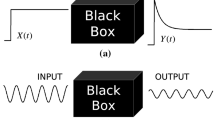Abstract
The paper considers a common operation principle of a quantum rotation sensor based on nuclear magnetic resonance, giving a semi-classical description of processes in the sensor circuit, that is useful for obtaining the analytical representation of a signal at the optical circuit output. The principles of numerical calculation are briefly presented for an optical signal of the rotation sensor based on a one-dimensional quantum model. Comparison of calculations according to classical model and more stringent quantum model has shown that the sensor signal has a more complicated structure than that following from the classical description which shows only some properties of dynamic processes in the circuit. The results are important for the development of methods for demodulating the quantum rotation sensor optical signal and for estimation of expected characteristics of practical devices.
Similar content being viewed by others
References
Larsen, M., and Bulatowicz, M., Nuclear Magnetic Resonance Gyroscope: For DARPA’s micro-technology for positioning, navigation and timing program, IEEE International Frequency Control Symposium Proceedings, 2012.
Woodman, O.J., An Introduction to Inertial Navigation: Technical Report no. 696, University of Cambridge Computer Laboratory, 2007.
Jekeli, C., Inertial Navigation Systems with Geodetic Applications, Walter de Gruyter, 2001.
Fang, J. and Qin, J., Advances in Atomic Gyroscopes: A View from Inertial Navigation Applications, Sensors (Basel), 2012, no. 12 (5), pp. 6331–6346.
Lefèvre, H.C., The Fiber-Optic Gyroscope: Challenges to Become the Ultimate Rotation-Sensing Technology, Optical Fiber Technology, 2013, vol. 19, issue 6, part B, pp. 828–832.
Rabi, I.I., Zacharias, J.R., Millman, S., and Kusch, P., A New Method of Measuring Nuclear Magnetic Moment, Physical Review, 1938, vol. 53, no. 4, pp. 318–327.
Pomerantsev, N.M., Yavlenie spinovykh ekho i ego primenenie (Spin Echo Phenomenon and Its Applications), UFN, 1958, no. 1, pp. 87–110.
Waters, G.S., and Francis, P.D., A Nuclear Magnetometer, Journal of Scientific Instruments, 1958, vol. 35, no. 3, pp. 88–93.
Gabuda, S.P., Pletnev, R.N., and Fedotov, M.A., Yadernyi magnitnyi rezonans v neorganicheskoi khimii (Nuclear Magnetic Resonance in Inorganic Chemistry), Moscow, Nauka, 1988.
Lauterbur, P.C., Image Formation by Induced Local Interactions: Examples Employing Nuclear Magnetic Resonance, Nature, 1973, vol. 242, pp. 190–191.
Maleev, P.I., Novye tipy giriskopov (New Types of Gyroscopes), Leningrad, 1971.
Simpson, J.H., Fraser, J.T., and Greenwood, I.A., An Optically Pumped Nuclear Magnetic Resonance Gyroscope, IEEE Trans. Aerosp. Support, 1963, vol. 1, pp. 1107–1110.
Fang, J.C. and Qin, J., Advances in Atomic Gyroscopes: A View from Inertial Navigation Applications, Sensors, 2012, vol. 12, pp. 6331–6346.
Donley, E.A., Nuclear Magnetic Resonance Gyroscopes, IEEE SENSORS 2010 Conference, 2010, pp. 17–22.
Litmanovich, Yu.A., Vershovskii, A.K., and Peshekhonov, V.G., Nuclear Magnetic Resonance Gyro: Past, Present, Future, 7-ya Rossiiskaya multikonferentsiya po problemam upravleniya, materialy plenarnogo zasedaniya (7th Russian Conference on Control Problems, Proceedings of the Plenary Session), St. Petersburg, 2014, pp. 35–42.
Meyer, D., and Larsen, M., Nuclear Magnetic Resonance Gyro for Inertial Navigation, Gyroscopy and Navigation, vol. 5, no. 2, pp. 75−82.
Walker, T.G., and Larsen, M.S., Spin-Exchange-Pumped NMR Gyros, Advances in Atomic, Molecular, and Optical Physics, 2016, vol. 65, pp. 373–401.
Kuraptsev, A.S. and Sokolov, I.M., Spontaneous Decay of an Atom Excited in a Dense and Disordered Atomic Ensemble: Quantum Microscopic Approach, Phys. Rev. A, 2014, vol. 90, issue 1.
Sokolov, I.M., Influence of Hyperfine Structure of the Atomic States on the Collective Effects in the Rb2 Quasi-molecule, Journal of Experimental and Theoretical Physics, 2017, vol. 125, no. 4, pp. 551–563.
Blum, K., Density Matrix Theory and Applications, Springer Series on Atomic, Optical and Plasma Physics, 2012.
Abraham, A., Yadernyi Magnetizm (Nuclear Magnetism), Moscow, Izdatelstvo inostrannoi literatury, 1963.
Popov, E.N., Barantsev, K.A., and Litvinov, A.N., Control of the Nuclear Spin of the 129Xe and 131Xe Isotopes in the Spin-Exchange Interaction with 87Rb Atoms, Physics of Wave Phenomena, 2016, vol. 24, no. 3, pp. 203–213.
Dong, H., Fang, J., Qin, J., and Chen, Y., Analysis of the Electrons-Nuclei Coupled Atomic Gyroscope, Optics Communications, 2011, vol. 284, no. 12, pp. 2886–2889.
Fang, J., Wan, S., and Yuan, H., Dynamics of an All-Optical Atomic Spin Gyroscope, Applied Optics, 2013, vol. 52 (30), pp. 7220–7227.
Author information
Authors and Affiliations
Corresponding author
Additional information
Original Russian Text © E.N. Popov, K.A. Barantsev, N.A. Ushakov, A.N. Litvinov, L.B. Liokumovich, A.N. Shevchenko, F.V. Sklyarov, A.V. Medvedev, 2018, published in Giroskopiya i Navigatsiya, 2018, No. 1, pp. 93–106.
Rights and permissions
About this article
Cite this article
Popov, E.N., Barantsev, K.A., Ushakov, N.A. et al. Behavior of Signal from Optical Circuit of Quantum Rotation Sensor Based on Nuclear Magnetic Resonance. Gyroscopy Navig. 9, 183–190 (2018). https://doi.org/10.1134/S2075108718030082
Received:
Published:
Issue Date:
DOI: https://doi.org/10.1134/S2075108718030082




